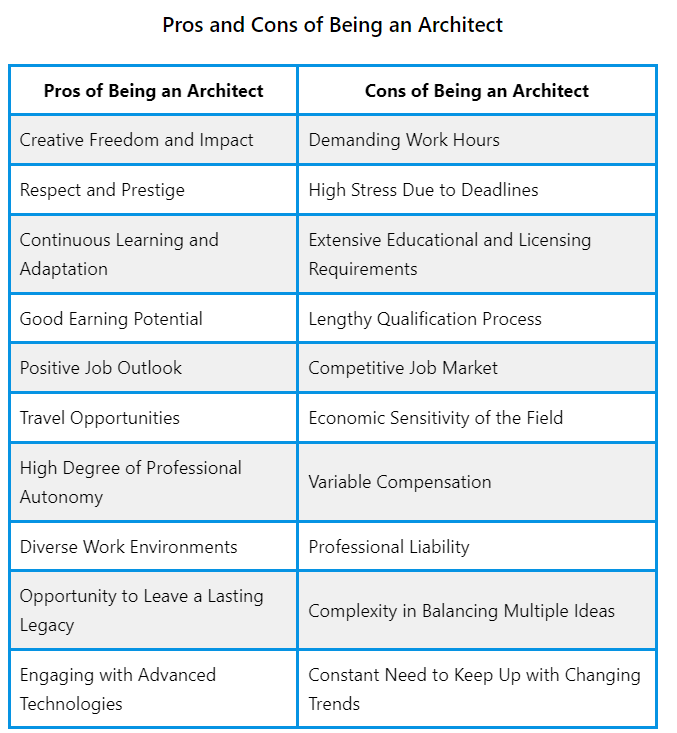The pros of being an architect are impactful work that shapes communities and environments, a platform for creativity, respect within the profession, competitive salaries, especially with experience, and the opportunity to engage in diverse, innovative responsibilities.
The cons of being an architect are long working hours, often due to tight deadlines, professional liability risks, a demanding educational path with expensive, challenging exams like the ARE (Architect Registration Examination). The need to navigate through competing design ideas, and adapting to the fluctuating economy, which can impact work-life balance.
Takeaways:
- Blend of creative expression and functional design
- Opportunity to shape the built environment and leave a lasting imprint
- Challenges in work-life balance, long hours, and navigating complex regulations and market shifts.
Architect: Quick Facts & Insights
Overview and Employment Statistics:
- 2022 Median Annual Wage: $82,840.
- Total Jobs in 2022: 123,700, with a projection to increase to 129,700 by 2032.
- Projected Growth (2022-2032): 5%, faster than the average for all occupations.
- Annual Openings Estimate: Around 8,200, primarily due to retirements and occupational transfers.
Educational and Professional Pathway:
- Degree Requirement: A bachelor’s degree in architecture is typically needed.
- Internship Experience: Relevant experience is gained through a paid internship.
- Licensure: Obtained by passing the Architect Registration Examination.
Industry Distribution and Wages:
- Primary Sectors: 76% in architectural, engineering, and related services; 13% self-employed; 4% in construction; 3% in government.
- Median Wages by Sector:
- Government: $103,170.
- Architectural, Engineering Services: $82,170.
- Construction: $80,480.

| Pros of Being an Architect | Cons of Being an Architect |
|---|---|
| Creative Freedom and Impact | Demanding Work Hours |
| Respect and Prestige | High Stress Due to Deadlines |
| Continuous Learning and Adaptation | Extensive Educational and Licensing Requirements |
| Good Earning Potential | Lengthy Qualification Process |
| Positive Job Outlook | Competitive Job Market |
| Travel Opportunities | Economic Sensitivity of the Field |
| High Degree of Professional Autonomy | Variable Compensation |
| Diverse Work Environments | Professional Liability |
| Opportunity to Leave a Lasting Legacy | Complexity in Balancing Multiple Ideas |
| Engaging with Advanced Technologies | Constant Need to Keep Up with Changing Trends |
Pros of Being an Architect

- Creative Freedom and Impact: Architects have the unique opportunity to use their creativity in designing spaces and structures that leave a lasting impact on communities and individuals. Their work goes beyond mere construction; they create environments that influence how people live, work, and interact. The ability to shape and enhance public and private spaces makes architecture a deeply fulfilling profession.
- Respect and Prestige: Architecture is a well-respected profession, often associated with a high level of expertise and sophistication. Being an architect comes with a sense of prestige, as they are seen as critical thinkers and visionaries in the realm of urban development and design. This respect is earned through the significant training and skill required to become an architect.
- Continuous Learning and Adaptation: The field of architecture is dynamic, constantly evolving with new design trends, technologies, and building materials. Architects have the chance to continuously learn and adapt, keeping their skills and knowledge fresh and relevant. This aspect of the profession ensures that architects are always at the forefront of design innovation and sustainability practices.
- Good Earning Potential: According to the U.S. Bureau of Labor Statistics, the median annual wage for architects was $82,840 in May 2022. With experience and a growing reputation, architects can earn even higher salaries. This financial reward is a significant benefit, reflecting the level of skill and dedication required in the profession.
- Positive Job Outlook: The employment of architects is projected to grow by 5% from 2022 to 2032, which is faster than the average for all occupations. This growth suggests a stable and positive job outlook for architects, providing reassurance of career longevity and opportunities for upcoming professionals in the field.
- Travel Opportunities: Some architects have the chance to travel, either to visit construction sites, attend conferences, or gain inspiration from different cultures and architectural styles. This aspect of the job can be highly rewarding, offering experiences and insights that can enhance their design perspective and approach.
- High Degree of Professional Autonomy: Many architects enjoy a high level of independence in their work, especially when running their own firms or working on individual projects. This autonomy allows them to make significant decisions about design and project execution, offering a sense of ownership and personal investment in their work.
- Diverse Work Environments: Architects can find opportunities in various sectors, such as government, construction, and architectural services. This diversity allows them to explore different aspects of architecture, from public infrastructure to private residences, enhancing their experience and versatility as professionals.
- Opportunity to Leave a Lasting Legacy: The work of architects often stands the test of time, leaving a tangible legacy through buildings and structures that may last for generations. This aspect of the profession is incredibly rewarding, as architects contribute to the cultural and historical fabric of societies through their designs.
- Engaging with Advanced Technologies: Architecture continually integrates new technologies, from advanced computer-aided design software to sustainable building materials and practices. This engagement with cutting-edge technology keeps the profession exciting and innovative, allowing architects to push the boundaries of what is possible in design and construction.
Cons of Being an Architect

- Demanding Work Hours: Architects often face long and irregular work hours, especially when meeting tight project deadlines. This aspect of the job can lead to a challenging work-life balance, as significant time and effort are required to ensure the success and quality of architectural projects.
- High Stress Due to Deadlines: The pressure to meet deadlines can be intense in architecture, leading to high stress levels. Architects must manage client expectations, project details, and team coordination, all while adhering to strict timelines, which can be a demanding and often stressful aspect of the job.
- Extensive Educational and Licensing Requirements: Becoming an architect requires a significant investment in education and training. Prospective architects typically need a bachelor’s degree in architecture, followed by a paid internship and passing the Architect Registration Examination. This long and rigorous process can be a deterrent for some.
- Lengthy Qualification Process: The time taken to qualify as an architect, including education, internships, and examinations, is considerable. This lengthy process requires dedication and patience, and it can be several years before one can practice independently as a licensed architect.
- Competitive Job Market: Architecture is a competitive field, with many aspiring architects vying for a limited number of positions. This competition can make it challenging to secure desirable jobs or projects, especially for those just starting in their careers.
- Economic Sensitivity of the Field: The demand for architectural services is often linked to the overall health of the economy, especially the construction sector. During economic downturns, such as recessions, the field can face uncertainty, leading to job instability or reduced demand for architectural services.
- Variable Compensation: While architects can earn a good salary, compensation can vary widely based on factors such as location, sector, and experience level. For example, architects in government roles tend to earn more than those in construction. This variability can be a concern for those seeking financial stability in the profession.
- Professional Liability: Architects carry a significant amount of professional liability, as errors or oversights in their work can lead to costly and sometimes legal consequences. This responsibility requires meticulous attention to detail and a thorough understanding of building codes and safety regulations.
- Complexity in Balancing Multiple Ideas: Architects often have to navigate and balance a multitude of competing ideas and requirements, from client preferences to practical constraints and regulatory compliance. This complexity can be challenging, requiring a high level of problem-solving skills and diplomacy.
- Constant Need to Keep Up with Changing Trends: The architecture field is continuously evolving, with new trends in design, sustainability, and technology emerging regularly. Architects must keep up with these changes to remain relevant and effective in their profession, which requires ongoing learning and adaptability.
Architectural Career Rewards

The career of an architect offers a unique blend of creative expression and the satisfaction of designing functional spaces that significantly impact individuals and communities. Engaging in architecture allows professionals to harness their creativity to formulate innovative plans that shape the environment. This aspect of the job can be immensely fulfilling, as architects witness their concepts evolve from sketches to tangible structures. The opportunity to design buildings that will be part of the urban landscape for decades, or even centuries, contributes to a deep sense of career satisfaction.
Additionally, architecture is widely regarded as a prestigious career due to the extensive skill set required to excel in the field. This respect translates into a variety of job opportunities across different sectors, as architects are essential in the planning and development of new constructions, renovations, and restorations. The diverse responsibilities associated with being an architect ensure a dynamic workday that is rarely monotonous.
Moreover, the financial rewards are considerable, with architects earning an average salary of $82,840 per year. This lucrative income reflects the level of expertise and dedication needed to succeed in the profession, making it an attractive career choice for individuals seeking both creative fulfillment and financial stability.
Creative Expression Opportunities

The role of an architect is uniquely poised at the intersection of art and functionality, where creative expression opportunities abound. By unleashing their artistic vision, architects can transform spaces into functional artwork that resonates with both utility and aesthetic appeal.
This dual capacity to design and innovate allows architects to leave a lasting imprint on the built environment, shaping the way communities interact with their surroundings.
Unleashing Artistic Vision
While balancing functionality with aesthetics, architects relish the opportunity to manifest their unique artistic visions into tangible reality through their designs. The profession of architecture is inherently creative, allowing practitioners to use their creativity to create something that is both practical and inspiring. Architects are tasked with designing buildings and spaces that reflect their artistic ethos while meeting the needs of their clients and the community.
| Creativity in Architecture | Functional Design | Lasting Impact |
|---|---|---|
| Artistic Exploration | Client Needs | Community Legacy |
| Innovation and Boundaries | Budget Adherence | Environmental Fit |
| Visionary Concepts | Regulatory Compliance | Cultural Significance |
Architectural work is a blend of visionary art and pragmatic problem-solving, leading to the creation of environments that are both beautiful and utilitarian.
Designing Functional Artwork
Harnessing the dual forces of creativity and practicality, architects embark on designing functional artwork that stands at the intersection of aesthetic appeal and utilitarian purpose.
Through architecture as a profession, these visionaries transform buildings and public spaces into more than mere structures; they become expressions of culture and identity.
The act of designing functional artwork affords architects the unique privilege of blending form with function, ensuring that the environments they create serve practical needs while also elevating the human experience.
As they craft these living, breathing canvases, architects contribute to the fabric of communities, leaving indelible marks that inspire and resonate with future generations.
Their work, a testament to the power of creative expression, redefines our interaction with the built world.
Social and Professional Networking

Social and professional networking is an indispensable tool for architects seeking to expand their horizons and forge meaningful industry connections. For professionals carving out a career in architecture, engaging with peers and industry leaders can lead to new opportunities and fruitful collaborations. Joining organizations like the American Institute of Architects not only keeps licensed architects abreast of industry trends but also facilitates peer connections that are invaluable when working as an architect.
Networking events and conferences are prime venues for architects to gain exposure, share ideas, and possibly secure potential business leads. A strong professional network can be a source of referrals and recommendations, which are essential for an architect’s project pipeline and reputation building.
Moreover, the digital age has enabled architects to leverage social media platforms, which serve as modern tools to showcase their portfolios and reach a wider audience. This online presence can attract clients and collaborators, thereby enhancing an architect’s professional stature and opening doors to global projects.
Educational Journey Requirements

Building upon the importance of networking for career advancement, the educational journey to become an architect is structured and rigorous, beginning with a minimum of a bachelor’s degree in architecture. This foundational degree encompasses a comprehensive curriculum that equips students with the theoretical knowledge and practical skills necessary for the profession.
Aspiring architects must enroll in a program accredited by the National Architectural Accrediting Board (NAAB), which ensures the quality and relevance of architectural education.
The educational prerequisites extend beyond the classroom. A typical accredited degree in architecture spans five years, followed by a mandatory three-year internship. This period of practical training is crucial for gaining hands-on experience under the supervision of licensed professionals. It is a bridge between academic learning and real-world application, preparing candidates for the professional challenges ahead.
Work-Life Balance Considerations

Architects frequently face the challenge of managing a delicate work-life balance due to the demands of long working hours and tight project deadlines. The nature of their work often leads to periods where the standard 40-hour workweek is exceeded, encroaching on personal time and potentially hindering a healthy work-life equilibrium. These extended periods of work are not just a matter of putting in more hours at the office; they reflect the intense level of focus required to balance creativity with the practicality of building codes and regulations.
Work-life balance considerations are further complicated by the pressure to meet client expectations, which can amplify stress levels and make it difficult for architects to disconnect from their work. Additionally, the need for ongoing professional development to stay abreast of industry advancements adds to the workload, as architects must dedicate time to learning and innovation outside of their regular project commitments.
The career as an architect, while fulfilling, does not always lend itself to predictability. Job prospects can be influenced by geographic location and economic fluctuations, which may affect job stability and, in turn, work-life balance. Consequently, architects must be adept at juggling the demands of their profession with their personal lives to maintain overall well-being.
Industry Challenges and Solutions

The architectural landscape is continually evolving, presenting professionals with the challenge of navigating complex regulatory environments.
Architects must adapt to market shifts, which often dictate new design trends and client demands.
Developing strategies to manage these challenges is essential for maintaining industry standards and achieving project success.
Navigating Regulatory Hurdles
Navigating the intricate labyrinth of building codes and regulations is a fundamental challenge that architects must master to ensure their designs comply with all necessary legal frameworks. The path to become an architect is paved with rigorous education requirements, often dictated by the National Architectural Accrediting Board, which lays the groundwork for understanding these regulatory hurdles.
Architects must stay abreast of zoning laws, environmental regulations, and ever-evolving building codes to avoid project delays and secure successful completion. Working closely with regulatory authorities becomes a crucial aspect of the architectural process, ensuring that plans not only meet aesthetic and functional criteria but also adhere strictly to the legal stipulations that govern construction and public safety.
Adapting to Market Shifts
In response to evolving industry dynamics, professionals in the field of architecture must continually adapt their strategies and methodologies to meet the shifting demands of the market. This necessity impacts their career path as they must acquire new skills and engage in continuing education to stay competitive.
To effectively navigate these market shifts, architects can:
- Embrace emerging trends:
- Develop expertise in sustainable and green design.
- Utilize technology for innovative designs.
- Expand collaboration:
- Work with other professionals for integrated solutions.
- Diversify services to meet broader needs.
- Invest in self-improvement:
- Pursue continuing education opportunities.
- Adapt to new regulations and client demands.
Continuous Learning and Adaptation

As architects, we must embrace continuous learning and adaptation to stay at the forefront of our field, integrating cutting-edge trends and technologies into our practice. The dynamic nature of architecture demands that we continually refine our skills involved in design, project management, and technological proficiency. This is particularly vital for aspiring architects who are just beginning their careers.
Continuous learning is not an option but a necessity to stay on top of evolving building codes, sustainability practices, and client preferences. It often takes years to complete the formal education required to become an architect, but the learning journey extends far beyond graduation.
Here’s a glimpse at how continuous learning and adaptation play out in an architect’s career:
| Aspect | Importance |
|---|---|
| Trends & Tech | Keeping up with modern design trends and technological advancements. |
| Building Codes | Adapting to changes in regulations to ensure compliance. |
| Professional Growth | Engaging in lifelong learning to refine and expand skill sets. |
| Innovation | Incorporating fresh ideas and tools to enhance creativity and efficiency. |
This table illustrates the critical areas where architects must focus their efforts for professional development, ensuring their designs are not only aesthetically pleasing but also relevant and compliant with current standards.
Conclusion
The architectural profession offers a labyrinthine tapestry of rewards and challenges.
As practitioners navigate the delicate equilibrium between innovation and responsibility, the career unfurls a spectrum of possibilities for creative and intellectual exploration.
Yet this path is not without its tribulations, demanding resilience in the face of stringent industry demands.
Ultimately, the measure of success in this field hinges on the ability to harmonize the fervor for design with the pragmatic constraints of the built environment.










